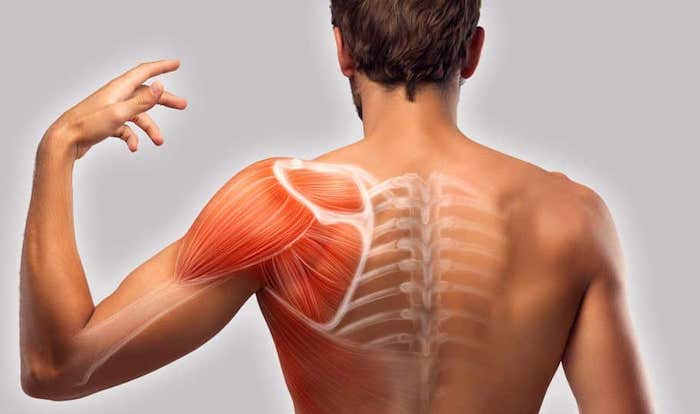
Having pain under or near your shoulder blade the triangular bone that forms the back of your shoulder may limit arm movements and interfere with daily activities. This pain can range from being sharp or burning, such as between the spine and shoulder blade, to tender or achy across the shoulder or upper back. Some possible causes of this pain are discussed below.
1. Poor Posture
Prolonged sitting with poor posture may cause your spine to undergo structural changes that eventually cause pain underneath the shoulder blade. Hunching your back, tilting your head down, or sitting to one side while working behind a desk or reading from a cell phone, for example, can weaken your muscles and place pressure on spinal discs, muscles, and ligaments. This routine imbalance can contribute to upper back pain.
2. Improper Lifting Technique
Lifting weight above your head without proper technique can leave your upper back and shoulders susceptible to injury. If you lift an object that is too heavy, or if the object is held away from the body with the spine misaligned, you can place undue pressure on your upper back. Lifting objects overhead that are too heavy can strain muscles or sprain ligaments, or potentially injure the shoulder joint or spine, which could refer to pain under or near the shoulder blade.
3. Overuse
Painting a ceiling, helping a friend move furniture, or participating in a softball league are all examples of activities that can put your upper back and shoulders through more work than they’re used to doing. Overuse can lead to muscle strains and ligament sprains, which can cause pain in the upper back, such as between your shoulder blade and spine. Another example is scapulothoracic bursitis, also called snapping scapula syndrome, in which the bursa between the shoulder blade (scapula) and the thoracic spine becomes inflamed and painful from overuse or injury.
4. Cervical Herniated Disc
A herniated disc in the cervical spine (neck) occurs when a disc’s outer layer (annulus fibrosus) tears and the inner layer (nucleus pulposus) starts to leak outward. A disc herniation can cause pain and may inflame a nearby nerve root that radiates pain down into the shoulder, arm, and/or hand. A disc herniation in the lower cervical spine is more likely to radiate pain into or near the shoulder blade area.1 While less common, it’s also possible for a disc herniation in the thoracic spine (upper back) to cause pain near the shoulder blade.
5. Dislocated Rib
While less common, a rib may pop out of place or become misaligned after repetitive strain or reaching for an item overhead. Sharp pain near your shoulder blade can result from this activity, and it can sometimes make it difficult to take a deep breath.
6. Heart Condition
Some heart conditions can present as pain in the shoulder blade region. For example, aortic dissection is a serious, life-threatening condition that occurs when the heart’s largest artery gets a tear and may cause severe pain that can move under or near the shoulder blade.2 A heart attack may also present as pain felt in the upper back and/or shoulder, especially in women.
7. Compression Fracture
A compression fracture is when a vertebral bone (typically in your upper back) weakens and compresses, causing back pain that feels better with rest or is sensitive to the touch. Compression fractures are most commonly caused by osteoporosis in older adults.
This list of possible reasons for the pain underneath your shoulder blade is not exhaustive, but hopefully, it gives you a helpful starting point on the journey to relief. Any back or shoulder pain that lingers a few weeks or interferes with daily activities should be evaluated by a doctor. If your pain is severe or accompanied by other red flag symptoms such as headache, tingling, weakness, or nausea seek immediate medical attention.
Precision Pain Care and Rehabilitation has two convenient locations in Richmond Hill – Queens and New Hyde Park – Long Island. Call the Richmond Hill office at (718) 215-1888, or (516) 419-4480 for Long Island office, to arrange an appointment with our Interventional Pain Management Specialist, Dr. Jeffrey Chacko.













